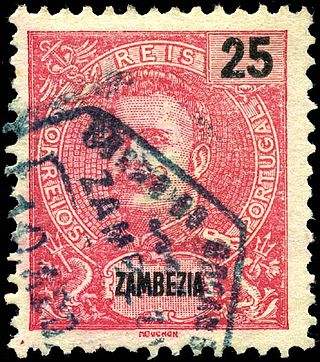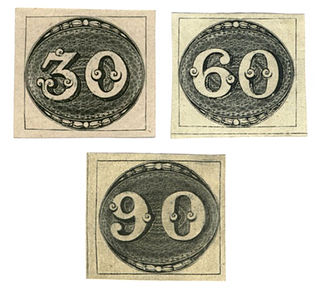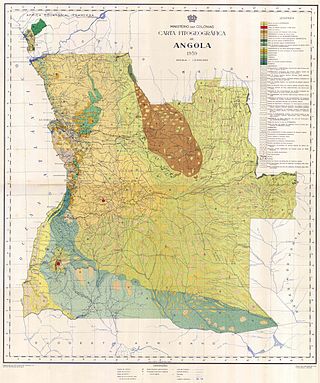This article needs additional citations for verification .(November 2014) |
This is a survey of the postage stamps and postal history of Angola .
This article needs additional citations for verification .(November 2014) |
This is a survey of the postage stamps and postal history of Angola .
A colony of Portugal since the 16th century, Angola was part of the Portuguese mail service.


Its first stamps date from 1870, six values depicting the Portuguese crown in a design common to all the colonies. New values and colors appeared periodically through 1885. In 1886, a series of nine featured an embossed silhouette of Luís I, followed in 1893 and 1898 by depictions of Carlos I.
As with the other Portuguese colonies, the 1910s were philatelically complex, with multiple overprints and surcharges applied to the existing stamp stocks. The Ceres series on 1914 outlasted the instability, with new stamps being added as late as 1926, for a total of 40 types.
The first commemorative stamps were a series of three showing a marble column surmounted by the Portuguese arms, marking the visit of President António Óscar Carmona in 1938. A set of 10 in 1948 commemorated the 300th anniversary of the recovery of Angola.
Two definitive series, one in 1951 consisting of 24 designs featuring native birds, and another of 20 stamps in 1953 depicting native animals, are notable as early stamps printed in full color. The 1950s and 1960s saw a number of additional long sets, including coats of arms, portraits of natives, local churches, and so forth. [1]
Stamps were issued for the present-day Cabinda Province as Portuguese Congo from 1894 to 1920. [2]
The first stamp of independent Angola was a 1.50-escudo value issued on 11 November 1975; it depicted a hand holding a rifle aloft, in front of a star. Initially the stamp program was conservative, with 20-30 stamps per year, but starting in the mid-1990s, large numbers of designs began to come out each year, eventually joined by adhesive labels inscribed "Angola" but not authorized by postal authorities and not valid for postage. Angola is a client of the Inter-Governmental Philatelic Corporation.

Indian postal systems for efficient military and governmental communications had developed long before the arrival of Europeans. When the Portuguese, Dutch, French, Danish and British conquered the Marathas who had already defeated the Mughals, their postal systems existed alongside those of many somewhat independent states. The British East India Company gradually annexed the other powers on the sub-continent and brought into existence a British administrative system over most of modern-day India, with a need to establish and maintain both official and commercial mail systems.
This is a partial timeline of significant events in postal history, including dates and events relating to postage stamps.

Zaire is one of the 18 provinces of Angola. It occupies 40,130 square kilometres (15,490 sq mi) in the north west of the country and had a population of 594,428 inhabitants in 2014. It is bordered on the west by the Atlantic Ocean, on the north by the Democratic Republic of Congo, on the east by the Uíge Province, and on the south by the Bengo Province.

On 1 January 1868, Portugal issued postage stamps for the islands of Madeira, consisting of the current stamps of Portugal overprinted "MADEIRA". Subsequent stamps were also overprinted, through 1881.

Although Zambezia was a part of the Portuguese East Africa Colony, the Portuguese government-issued separate postage stamps for it starting in 1894, with the standard design depicting King Charles, and likewise in 1898. A provisional issue came in 1902 to reflect changed rates, then after the revolution of 1910 there were several issues overprinted "REPUBLICA". The postal districts of Quelimane and Tete were created from parts of Zambezia in about 1913, and then stamps of Mozambique replaced stamps of Zambezia around 1920.

Postage stamps and postal history of the Azores surveys the postal history of the Portuguese archipelago, situated in the north Atlantic.

Gabon is a country in west central Africa sharing borders with the Gulf of Guinea to the west, Equatorial Guinea to the northwest, and Cameroon to the north, with the Republic of the Congo curving around the east and south. Its size is almost 270,000 km2 with an estimated population of 1,500,000. The capital and largest city is Libreville.
Each "article" in this category is a collection of entries about several stamp issuers, presented in alphabetical order. The entries are formulated on the micro model and so provide summary information about all known issuers.
This is a survey of the postage stamps and postal history of Macau.

The Ceres series of Portuguese postage stamps is a definitive series depicting the Roman goddess Ceres that was issued between 1912 and 1945 in Portugal and its colonies.

The Mexican postal system has its roots in the Aztec system of messengers which the Spanish adopted after the Conquest. A postal service was established in 1580, mainly to communicate between the viceroyalty of New Spain with the motherland Spain. During the 18th century, Spain established a formal postal system with regular routes. In 1856, Mexico issued its first adhesive postage stamps, with "district overprints", a unique feature among postal systems worldwide, employed to protect from theft of postage stamps.

In general, philatelic fakes and forgeries are labels that look like postage stamps but have been produced to deceive or defraud. Learning to identify these can be a challenging branch of philately.

The postal history of Malta began in the early modern period, when pre-adhesive mail was delivered to foreign destinations by privately owned ships for a fee. The earliest known letter from Malta, sent during the rule of the Order of St John, is dated 1532. The first formal postal service on the islands was established by the Order in 1708, with the post office being located at the Casa del Commun Tesoro in Valletta. The first postal markings on mail appeared later on in the 18th century.

A postal museum is a museum dedicated to the display of objects relating to the postal service. A subcategory of postal museums are philatelic museums, which focus on philately and postage stamps.

Ícolo e Bengo is a city council in the province of Luanda in Angola. It had a population of 81,144 in 2014.

Brazil is the fifth largest country in the world. It was a colony of Portugal from 1500 until 1815.

This is a survey of the postage stamps and postal history of Guinea-Bissau, formerly known as Portuguese Guinea.

Johannes Gossweiler aka John Gossweiler or João Gossweiler, was state botanist to the Government of Angola from 1899 until his death. He made important collections in every district of Angola and created the first phytogeographic map of that country. His collections of African plant specimens were sent regularly to Lisbon, the British Museum, the Royal Botanic Gardens, Kew, and the University of Coimbra. Duplicates were also kept at the Herbarium of the Instituto de Investigação Agronómica in Angola. Today, many herbaria contain specimens he collected.

The Naked Maja is a philatelic name for three postage stamps of Spain of 1930 depicting the La maja desnuda painting (1800) by Francisco de Goya (1746–1828). They are part of a set marking the anniversary of the death of this Spanish artist, and are sometimes incorrectly considered the world's first postage stamp with nudes.

The Porto Customshouse Congress Centre is a convention centre and former-customshouse situated in the civil parish in Cedofeita, Santo Ildefonso, Sé, Miragaia, São Nicolau e Vitória, in the northern Portuguese municipality of Porto. The building is located in the historic centre of the city, along the bank of the Douro River, and was renovated under the direction of the Pritzker-awarded architect Eduardo Souto de Moura. It is part of the Museum of Transport and Communication, founded on 21 February 1992, as a non-profit institution comprising 56 individual associates and 25 institutional associates.